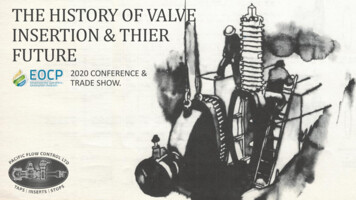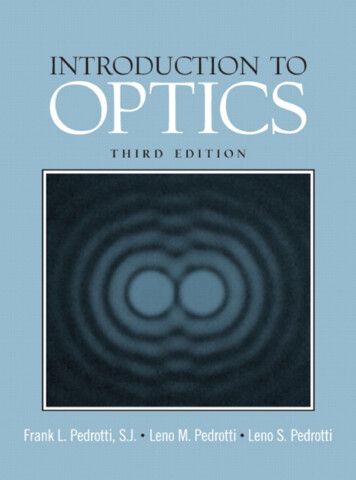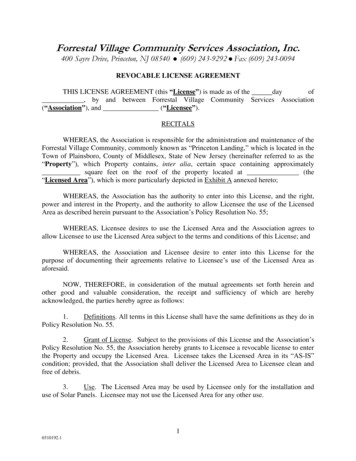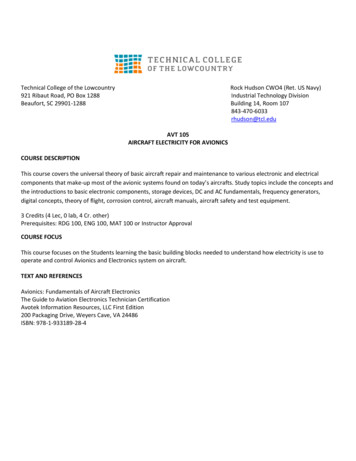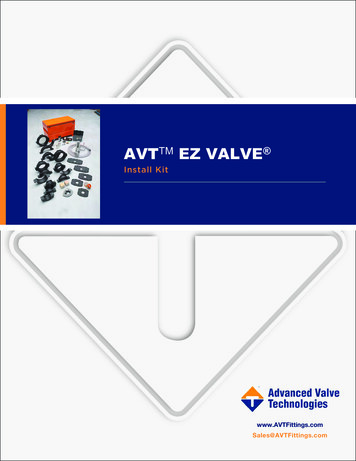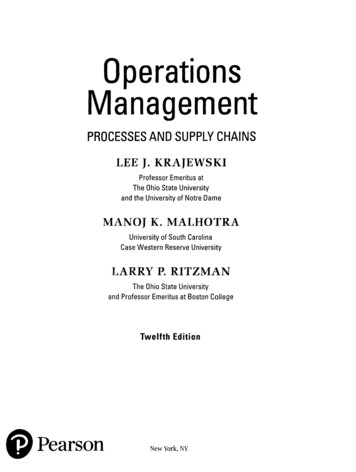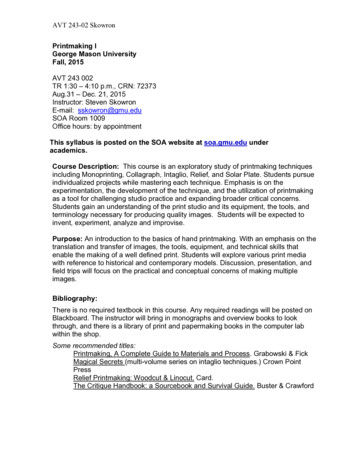
Transcription
AVT 243-02 SkowronPrintmaking IGeorge Mason UniversityFall, 2015AVT 243 002TR 1:30 – 4:10 p.m., CRN: 72373Aug.31 – Dec. 21, 2015Instructor: Steven SkowronE-mail: sskowron@gmu.eduSOA Room 1009Office hours: by appointmentThis syllabus is posted on the SOA website at soa.gmu.edu underacademics.Course Description: This course is an exploratory study of printmaking techniquesincluding Monoprinting, Collagraph, Intaglio, Relief, and Solar Plate. Students pursueindividualized projects while mastering each technique. Emphasis is on theexperimentation, the development of the technique, and the utilization of printmakingas a tool for challenging studio practice and expanding broader critical concerns.Students gain an understanding of the print studio and its equipment, the tools, andterminology necessary for producing quality images. Students will be expected toinvent, experiment, analyze and improvise.Purpose: An introduction to the basics of hand printmaking. With an emphasis on thetranslation and transfer of images, the tools, equipment, and technical skills thatenable the making of a well defined print. Students will explore various print mediawith reference to historical and contemporary models. Discussion, presentation, andfield trips will focus on the practical and conceptual concerns of making multipleimages.Bibliography:There is no required textbook in this course. Any required readings will be posted onBlackboard. The instructor will bring in monographs and overview books to lookthrough, and there is a library of print and papermaking books in the computer labwithin the shop.Some recommended titles:Printmaking, A Complete Guide to Materials and Process. Grabowski & FickMagical Secrets (multi-volume series on intaglio techniques.) Crown PointPressRelief Printmaking: Woodcut & Linocut. Card.The Critique Handbook: a Sourcebook and Survival Guide. Buster & Crawford
AVT 243-02 SkowronIn addition, this course is designed to:1) Stimulate perceptual growth and visual awareness in the student.2) Identify printmaking tools, methods, materials, and mediums as well asdemonstrate skill and craft in their usage.3) Conceptualize an idea and then compose it into an aesthetically resolved artwork.4) Use creative process, including experimentation, to analyze and solve problemsand explain why creativity is an important mode of human expression.5) Utilize digital software and technology for research and image manipulation.6) Apply a set of criteria to evaluate a work of art.7) Utilize recommended health and safety practices, and demonstrate the ability towork cooperatively with others in a Printmaking Studio setting.8) Demonstrate reasonable oral and written skills using correct Printmakingterminology.9) Demonstrate an awareness of the art making traditions of various cultures.10) Create a portfolio of work that can be used for job and/or educational placement.Student Participation and Evaluation: Students develop a suite of prints or otherrelated investigation in tandem with their studio work or based on a theme of theinstructor’s choosing or their own in consultation with the instructor.Students are required to keep all of their work completed throughout the semester.Critiques and portfolio reviews will be the primary method of student evaluation.Since evaluation is based on work done in class, class attendance ismandatory. It is important to be on time since all demonstrations will be conductedat the beginning of class. If the student is 15 minutes late they will be counted asabsent.- (see grading criteria)Requirements:1) A sketchbook/notebook for ideas, lecture notes, diary entries2) Participation in all classes, visiting artists, discussions and critiques3) Care and Maintenance of the Print Studio4) Twelve hours (minimum) per week outside of class required (4 credits)5) Three documented independent field trips to area museums, galleries, in DC6) 1 Documented Artists Report for Visiting Artists/Lecture (Visual Voices)7) A written paper and class presentation before mid term grades.8) One ArtsBus trip to New York is required if an AVT MajorShop Rules & SafetyUse solvents and acids only in designated areas.Wash hands thoroughly with soap after working with ink and solvents.Always thoroughly clean your station after printing.Keep clean paper areas clean.Do not place hot plates on glass tables.Wear gloves and protective eyewear when using the acid baths.Wear mask when applying aquatint.Place newsprint over print when running it through the press. Do not get ink on pressblankets.
AVT 243-02 SkowronImmediately after running print through press, wipe off the press bed.Do not leave anything on the press bed; tape, ink, plate etc.Remove prints from racks as soon as they are dry.Dispose of trash in proper bins. There are special bins for solvent-soaked rage, paper scrapsand regular trash.Course OutlineI.I.IntroductionDiscussion of printmaking as both a formal study and a tool forexploration of other media. Emphasis on developing expressive markmaking, cultivating personal style, and drawing from experience.Relief printmaking: Linoleum block printsRelief is explored as a medium that embraces the aesthetics of line,shape, and space. Students receive instruction on learning the processof printing through in-class demonstrations that include: carving,printing, and editioning.II.Monotype/Monoprint: Using plexiplates, exploration into additive andsubtractive methods, stencils will be explored. A unique suite will becreated for the both projects.III.Collograph: Using matt board as the matrix, this is a intaglio processwhich will explore adhering various materials to the matrix to createtexture and embossing elements into the final image. This technique alsoembraces textural qualities, along with endless possibilities of color andvariation.IV.Intaglio printmaking: Drypoint and EtchingEtching involving hardground, aquatint and reworking of images isexplored. Students learn multiple-state biting of zinc plates, properplate wiping technique, chine colle, and editioning.V.Solarplate: Provided we have the class time to explore this process.VI.Final Print Exchange, Portfolio Critique, and Review
AVT 243-02 SkowronMATERIALS LIST1. A flat file drawer will be provided for you to store your paper and prints madeduring the course.2. There are lockers in the hallway available for rental.3. The following are provided: 1 zinc plate, 1 linoleum block, Solarplate, newsprint,printing ink, 1 sheet of Rives BFK, 1 sheet of proofing paper. Some tools areavailable to borrow. Many consumables are provided.Students are responsible for supplying the following items:(LABEL YOUR SUPPLIES WITH YOUR INITIALS)Sketchbook/journalSketching media: graphite pencils, markers, pens, charcoal etc.)Sharpee marker1 sheet of clear acetate or mylarSmall pad of tracing paper1 Combination Etching Needle and Burnisher1 Set of Speedball Linoleum Cutter with 5 bladesArtist tape or painter’s tapeOne Pair Neoprene Rubber Gloves OR1-box Nitrile disposable gloves (no powder) Giant/Harbor Freight/CostcoOne Portfolio Case, approx. 23”x31” (to transport and hold your prints)Tool box/tackle box for suppliesOne X-acto knife with 11# bladeOne pgk. X-acto bladesOpt. apron or work clothesNew or used toothbrush1-small bottle acrylic gloss medium (do not get gloss or matt medium)Printmaking Paper:10 sheets Stonehenge (dickblick 2.55 a sheet) whiteRice paper:2 sheets minimumArt Supply StoresPlaza Art3045 Nutley StreetPan Am Shopping CenterFairfax (703) 280-4500University BookstoreJohnson Learning CenterGMU Campus(701) 993-2668
AVT 243-02 SkowronOnline storesMcClain’s Printmaking Supplieswww.imcclains.com310-998-0098Hiromi Paper sance Graphic Arts, Inc.www.printmaking-materials.com(215) 357-5705Rice Printmaking Paper: You can find rice paper at Plaza Arts, Utrecht, but notnecessarily at craft stores. Look for unadorned paper in white or natural with asoft, matte surface. Mulberry, Thai Mulberry, Kozo, Kitakata, Okawara, Hoshoare available locally. You can also mail-order these papers. They can get quiteexpensive, so look for a sheet that is around 24 x 36” and under 5. You willneed two sheets. Note that the dimensionsis not universal, so each “brand” may be a different size. Masa is very cheap, butlooks it. Sekishu is excellent, but more expensive. A sheet of Okawara andKitakata each would be a good bet.Western Printmaking Paper: There are many types of western printmakingpapers available locally. Standard is Rives BFK, available in several colors. Alsolook for Arches Cover, Somerset Satin or Velvet, Fabriano Rosaspina or Tiepolo,or for the budget-minded: Rives HWT, Rives LWT. Stonehenge, althoughinexpensive, is better for drawing & screenprint, but acceptable for block-printing.If you cannot spare the money for the better paper, then buy 4 sheets ofStonehenge or Folio (a domestic proofing paper), and 4 sheets of Rives HWT.Western paper’s standard size is 22 x 30 (with the exception of Rives HWT andLWT), and should run between 4- 5. You will need 8-10 sheets. You don’t haveto buy them all at once; four sheets will do to start. Choose some white sheets,and augment with a cream and a grey color. These papers can be mail-ordered.GMU Print Guild: Open to students, alumni, and public ( 20 annualmembership.) The Guild meets regularly on Friday, and members can use thestudio on Friday and Saturday. Please take advantage of this lively organizationand join them in events, shows, workshops, and projects. If you are working inthe studio on weekends, you’ll find they offer a wealth of information
AVT 243-02 SkowronGrading CriteriaEvaluation of your projects (all projects) will constitute 50% of your grade - 15% will be for improvement and35% will be for all over quality of concept, craft and expression. Your level of class participation willconstitute the remaining 50% of the grade, this will include quiz’s.Grading will take into account:QUALITY – does the student understand the medium and use it to best advantage?CONSISTANCY – can a student pull an edition of like printsQUANTITY – has the student done more than the number of prints and plates that were required?INVENTIVENESS – has the student been creative and done more than was assigned?F 1/3rd of the course assignments have not been successfully completed - your level of participation is notacceptable for university study;D most assignments have been competed - your level of success and/or class participation is belowaverage;C all assignments have been completed on time - your level of success, attendance and class participationis average for GMU;B assignments have been completed at levels above average for GMU, work shows some initiative, is verywell presented & demonstrates a clear understanding of the assignment, regular attendance, your classparticipation raised the level of the class;A a remarkable achievement measured on a national scale - achieved extraordinary initiative, originalthought and extra effort - you demonstrated leadership in the classPortfolio Of Projects - Overall (50%) General Improvement (15%)Class Participation (35%) Absences / Shop Care (Diminished grade)Class ParticipationClean UpStudents are responsible for cleaning up after themselves so that the room is ready for the next class.At the end of the semester, please thoroughly clean out your locker/file. Do not leave anythingbehind.CritiquesWe will hold periodic informal critiques throughout the semester. The critiques are designed to helpstudents improve their work and develop a vocabulary to discuss their own work as well as the workof their classmates. Participating in the critiques is mandatory.Journal/SketchbookStudents are required to keep a journal or sketchbook. It should be brought to class every week andused to explore creative ideas, keep notes on demos, problem solve etc. Basically, include anythingand everything that relates to processes, techniques, readings, and ideas that arise from practicingand thinking about printmaking. I encourage you to use the sketchbook for your own personalexploration of concepts and media. Ultimately, your sketchbook provides a place to document yourvisual development and experiences during class but most importantly allows ideas to grow.6
AVT 243-02 SkowronFinal Evaluation/Portfolio Review (December 10)The final evaluation will be based on work done in class, homework, and sketchbook assignments.The portfolio of work should be arranged in chronological order containing all in and out-side of classwork. Portfolios are used to evaluate your effort, productivity, and progress. 2-4 page paper due.Also required: Make one print from each print process to go into the college print archive** Be sure to save all of your work throughout the semester and store it in a flat file drawer.Class Schedule:Week One (9/1, 9/3)Tues. - Introduction to the course (supply list, syllabus)Walk through of the print shop.Discussion of printmaking as both a formal study and a tool for exploration of other media. There willbe an emphasis on cultivating personal style and drawing from experience. Students must keepdrawing journal to be used for projects. Examples of linocut prints are shown in class.Thurs. – Demonstration of the linocut technique. Abstract pattern/Repetition – project discussed.Come to class with supplies.Week Two (9/8, 9/10)Tues./Thurs. Linocut continued. Paper preparation, inking the block and printing (both by hand andpress) are demonstrated in class. Class time devoted to work time.Create an edition of 5 prints.*visiting artist Helen Zughaib will be in the studio, please be prepared to ask questionsVisual Voices Lecture: Thursday @7:20-9:00pm attendance required-writing assignment distributedWeek Three (9/15, 9/17)Tues. – Multi-color printing of one block. Create an edition of 5 prints.Thurs. – Lino continued, printing day.Week Four (9/22, 9/24)Tues. - Thurs. – Critique. Intro. to intaglio. Drypoint. Project theme discussed. Edition of 5 printsexpected for midterm review. Demo on plate preparation and working the plate.Week Five (9/29, 10/1)Tues. Thurs. – Studio time to work on projects. Demo on printing and paper. Ink preparation, properwiping techniques as well as paper preparation is covered. Wiping of plates is begun by students.Press printing is demonstrated.Week Six (10/6, 10/8)Tues./Thurs.- Studio time to work on project.Critique- of drypoint printsWeek Seven (10/13) No Class (Columbus Day Recess-Monday classes meet this day(10/15)– Studio time to work. Mid-term evaluations. Edition of b&w linocut prints,7
AVT 243-02 Skowronmulti-color lino prints, drypoint and Visiting artist paper due. Possible Quiz.Week Eight (10/20, 10/22) Intro. next project, theme discussed: Monoprint/Monotype. Print anedition of five.Week Nine (10/27, 10/29)Tues./Thurs - Hardground Etching – Various line making techniques are explored. Instruction on theuse of acids is given with emphasis on achieving line weight, gauging biting times and the use of stopout.Week Ten (11/2, 11/5)Project continued. Intro. to softground Etching – Demo on how to create texture and pattern. Inkingplate and press print the image. Students incorporate technique into their print. Aquatint – as ameans of introducing painterly techniques onto linear medium. Demonstration of spray paint.Aquatinting process, including grain control, tone control and manipulation through stop outtechniques are covered. Students use drawings from journal to execute aquatint space study overhardground image.Week Eleven (11/10, 11/12)Etching continued.Week Twelve (11/24)Critique/ Introduction to Collographs, theme introduced.(11/26) No class- Thanksgiving Recess*****************Week Thirteen (12/1, 12/3)Collograph printingWeek Fourteen (12/8, 12/10)Collograph editioning-Final critique, Final print project submitted and reworks and remaining printssubmitted as part of your portfolio and final grade. Possible quiz regarding use of materials, terms,process order. (anything covered via handouts and or discussed during class is fair game.)Week Fifteen (12/15)All work will be available for pick up, work that is not picked up after 5pm will be thrown out.Professor reserves the right to change the order of projects or makesubstitutions or modify time frame for projects.8
AVT 243-02 SkowronRULES OF THE PRINTSHOP:1) Clean up after yourself and others if necessary. If it wasn’t “dirty” when you arrived make surethe space is not “dirty” when you leave.2) Do not leave ink out or on any surface or any tool.3) This is not a private studio. Many people must share the space. Keep it clean. Cleansurfaces and tools thoroughly with vegetable oil and mineral spirits.4) Respect the Instructor and other students’ rights to the space and the materials. Do not useother students materials, maintain a controlled work space, do not take any shared tools,materials etc. out of the studio, and put tools and ink back in their original place after use.If at any time during the semester I discover that students are not maintaining the studio in aclean and respectful manner the print shop will be closed to everyone for up to one week.Assignments will still be due, class will meet on schedule, but work after class and onweekends will cease.Hours the Studio is Available:Schedule and rules are posted on the door. Failure to follow the rules will result in the closing of ALLopen studio hours.Sign, cut off and return to the professor by the end of the third class meeting.I have read and understand all parts of the syllabus and the requirements of this course.Name Date .9
AVT 243-02 SkowronUniversity and School of Art PoliciesIn accordance with George Mason University policy, turn off all cellular telephones and other wireless communication devices atthe start of class. The instructor of the class will keep his/her cell phone active to assure receipt of any Mason Alerts in a timelyfashion; or in the event that the instructor does not have a cell phone, he/she will designate one student to keep a cell phone active toreceive such alerts.Commitment to DiversityThis class will be conducted as an intentionally inclusive community that celebrates diversity and welcomes the participation in thelife of the university of faculty, staff and students who reflect the diversity of our plural society. All may feel free to speak and to beheard without fear that the content of the opinions they express will bias the evaluation of their academic performance or hinder theiropportunities for participation in class activities. In turn, all are expected to be respectful of each other without regard to race, class,linguistic background, religion, political beliefs, gender identity, sex, sexual orientation, ethnicity, age, veteran’s status, or physicalability.Statement on Ethics in Teaching and Practicing Art and DesignAs professionals responsible for the education of undergraduate and graduate art and design students, the faculty of the School of Artadheres to the ethical standards and practices incorporated in the professional Code of Ethics of our national accreditationorganization, The National Association of Schools of Art and Design (NASAD).Open Studio HoursSOA teaching studios are open to students for extended periods of time mornings, evenings and weekends whenever classes are not inprogress. Policies, procedures and schedules for studio use are established by the SOA studio faculty and are posted outside thestudios.School of Art Print StudioSchool of Art Print Studio (SOAP) is located in the School of Art Building on the Fairfax Campus. As a non-profit studio, SOAPoffers a variety of services including printing and production services to students, faculty and staff. All jobs are processed with highquality materials on state-of-the-art equipment, specifically for graphic design portfolios, mixed-media paintings and reproductions,posters, handmade books, student assignments and proof sheets. More information can be found at soaprint.gmu.edu or 703-9937203.ArtsBus Dates and CreditFall 2015September 26thOctober 24thNovember 21stEach student must have up to 5 AVT 300/Artsbus credits before graduation. For credit to appear on your transcript you must enroll inAVT 300. This also applies to anyone who intends to travel to New York independently, or do the DC Alternate Assignment.If you plan/need to go on multiple ArtsBus trips during a semester and need them towards your total requirement, you must enroll inmultiple sections of AVT 300. Please go to the ArtsBus website: http://artsbus.gmu.edu "Student Information" for additional, veryimportant information regarding ArtsBus policy.Non-AVT majors taking art classes do not need Artsbus credit BUT may need to go on the Artsbus for a class assignment. You caneither sign up for AVT 300 or buy a ticket for the bus trip at the Center of the Arts. Alternate trips must be approved by the instructorof the course that is requiring an ArtsBus trip.10
AVT 243-02 SkowronVisual Voices Lecture Series Fall 2015Visual Voices is a year-long series of lectures by artists, art historians and others about contemporary art and art practice. VisualVoices lectures are held on Thursday evenings from 7:20- 9:00 p.m. in Harris Theater.September 3rd Jon Rubin “Art in Public Life”September 10th Helen Zughaib “Arab Song – Arab Spring”September 24th Catherine Kehoe “It’s Not What You Think”October 1st SOA Grads “Loading Content”October 8th Steve Badanes Linda Beaumont “Speak of the Devil”For AVT 103, 104, 215, 222, 232, 243, 252, 253, 262, 272This class fulfills a Mason Core requirement for Arts.Mason courses in the filmmaking, visual and performing arts stress generative, inquiry based learning through directaesthetic and creative experience in the studio environment. Art history courses address the intrinsic relationship ofpersonal and cultural creativity, and the manifestation of aesthetics, visual culture and visual narrative withinhistorical contexts.Learning Outcomes:Students who successfully complete a course in the Arts category must meet the first learning outcome and aminimum of two of the remaining four learning outcomes:1.2.3.4.5.Demonstrate an understanding of the relationship between artistic process, and a work’sunderlying concept, and where appropriate, contexts associated with the work.Identify and analyze the formal elements of a particular art form using vocabulary andcritique appropriate to that form.Analyze cultural productions using standards appropriate to the form, as well as the workscultural significance and context.Analyze and interpret the content of material or performance culture through its social,historical, and personal contexts.Engage in generative artistic processes, including conception, creation, and ongoing criticalanalysis.11
AVT 243-02 SkowronImportant DeadlinesLast Day to Add - Tuesday, September 8Last Day to Drop (No Tuition Penalty) - Tuesday, September 8Final Drop (67% Tuition Penalty) – October 2Selective Withdrawal Period – October 5 - October 23Incomplete work from Spring/Summer 2015 due to instructor - October 30Once the add and drop deadlines have passed, instructors do not have the authority to approverequests from students to add or drop/withdraw late. Requests for late adds (up until the last dayof classes) must be made by the student in the SOA office (or the office of the departmentoffering the course), and generally are only approved in the case of a documented universityerror (such as a problem with financial aid being processed) , LATE ADD fee will apply.Requests for non-selective withdrawals and retroactive adds (adds after the last day of classes)must be approved by the academic dean of the college in which the student’s major is located.For AVT majors, that is the CVPA Office of Academic Affairs, College Hall C211.Students with Disabilities and Learning DifferencesIf you have a diagnosed disability or learning difference and you need academic accommodations, please inform meat the beginning of the semester and contact the Disabilities Resource Center (SUB I room 234, 703-993-2474).You must provide me with a faculty contact sheet from that office outlining the accommodations needed for yourdisability or learning difference. All academic accommodations must be arranged in advance through the DRC.Official Communications via GMU E-MailMason uses electronic mail to provide official information to students. Examples include communications fromcourse instructors, notices from the library, notices about academic standing, financial aid information, classmaterials, assignments, questions, and instructor feedback. Students are responsible for the content of universitycommunication sent to their Mason e-mail account, and are required to activate that account and check it regularly.Attendance PoliciesStudents are expected to attend the class periods of the courses for which they register. In-classparticipation is important not only to the individual student, but also to the class as a whole.Class participation may be a factor in grading, therefore instructors may use absence, tardiness,or early departure as de facto evidence of nonparticipation. Students who miss an exam with anacceptable excuse may be penalized according to the individual instructor's grading policy, asstated in the course syllabus.Honor CodeStudents in this class are bound by the Honor Code, as stated in the George Mason University Catalog. The honorcode requires that the work you do as an individual be the product of your own individual synthesis or integration ofideas. (This does not prohibit collaborative work when it is approved by your instructor.) As a faculty member, Ihave an obligation to refer the names of students who may have violated the Honor Code to the Student HonorCouncil, which treats such cases very seriously.No grade is important enough to justify cheating, for which there are serious consequences that will follow you forthe rest of your life. If you feel unusual pressure about your grade in this or any other course, please talk to me or toa member of the GMU Counseling Center staff.Using someone else’s words or ideas without giving them credit is plagiarism, a very serious Honor Code offense. Itis very important to understand how to prevent committing plagiarism when using material from a source. If youwish to quote verbatim, you must use the exact words and punctuation just as the passage appears in the original andmust use quotation marks and page numbers in your citation. If you want to paraphrase or summarize ideas from a12
AVT 243-02 Skowronsource, you must put the ideas into your own words, and you must cite the source, using the APA or MLA format.(For assistance with documentation, I recommend Diana Hacker, A Writer’s Reference.) The exception to this rule isinformation termed general knowledge—information that is widely known and stated in a number of sources.Determining what is general knowledge can be complicated, so the wise course is, “When in doubt, cite.”Be especially careful when using the Internet for research. Not all Internet sources are equally reliable; some are justplain wrong. Also, since you can download text, it becomes very easy to inadvertently plagiarize. If you use anInternet source, you must cite the exact URL in your paper and include with it the last date that you successfullyaccessed the site.Writing CenterStudents who are in need of intensive help with grammar, structure or mechanics in their writing should make use ofthe services of Writing Center, located in Robinson A116 (703-993-1200). The services of the Writing Center areavailable by appointment, online and, occasionally, on a walk-in basis.13
Printmaking I George Mason University Fall, 2015 AVT 243 002 TR 1:30 - 4:10 p.m., CRN: 72373 Aug.31 - Dec. 21, 2015 Instructor: Steven Skowron E-mail: sskowron@gmu.edu SOA Room 1009 Office hours: by appointment This syllabus is posted on the SOA website at soa.gmu.edu under


